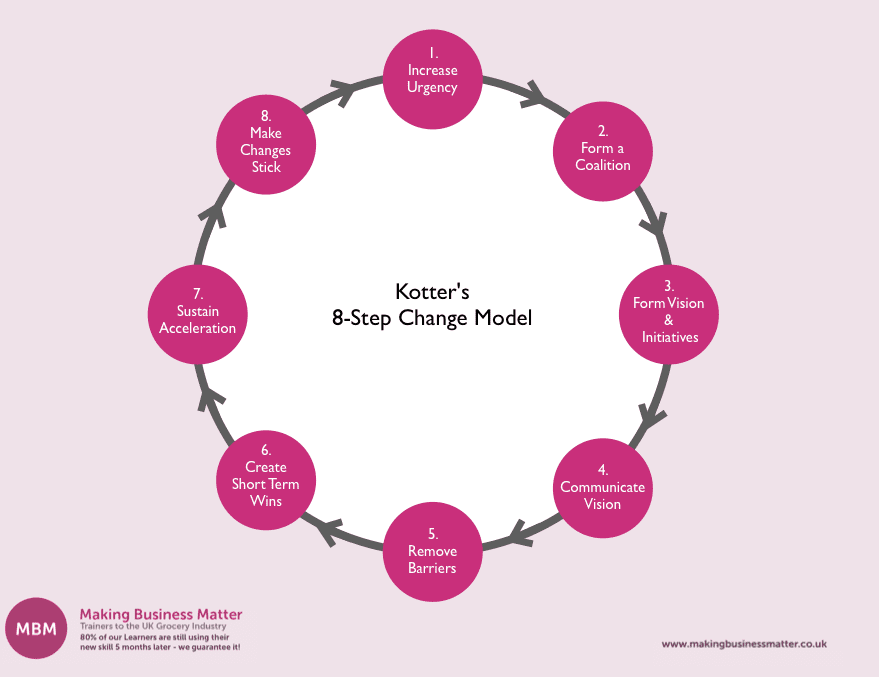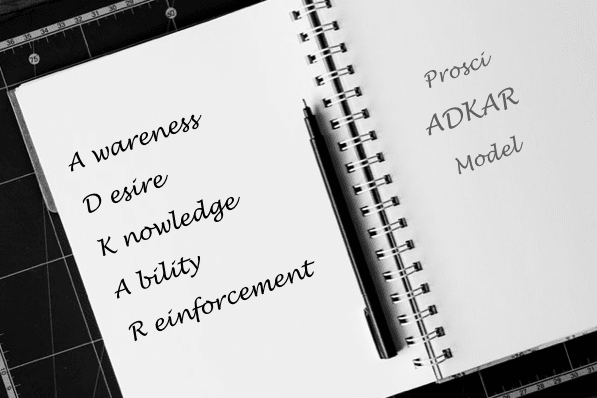How to Successfully Implement Change Management in Your Organisation
Change happens because someone, or a group of people, want to alter things. They want to make them better. It is essential, however, for all changes to be well planned, structured and implemented. This is where effective change management comes into play.
Imagine a time with no computers, internet, or smartphones. What if we were still in an era of filling out paper forms, using manual filing, or going to the library to conduct research? It may seem nice to go back in time. However, we have grown in knowledge with the use of computers. Furthermore, the internet has changed many things. Would you still be in business if you hadn’t integrated technology into your operations? [..and every other facet of your business for that matter!] Unlikely.
Change is about constantly evolving and adapting. It is essential for organisations to adapt their systems, processes, and culture to keep up with the industry. What worked yesterday will not necessarily bring success tomorrow. We must continuously innovate. Failure to adapt to change will only lead to decline and, ultimately, failure of the business.
What is Change Management?
According to the Oxford dictionary, change management is ‘the management of change and development within a business or similar organisation’. Organisational change management occurs when a company makes a transition from its current state to a desired future state. The primary goal of applying change is to implement new processes, products, and business strategies within an organisation while minimising negative results. Thus, if the employees, customers, and leaders handle the changes well, they will do well.
In the video below, Penny Moyle the former CEO of OPP provides some interesting insights into her approach to change management, drawing from her background as a business psychologist:

Why Change Management Doesn’t Always Work
Sometimes change isn’t applied correctly. Thus, executing the change in businesses doesn’t always work. Every company faces challenges. Employees may not understand why change must occur when a business is doing well.
According to a survey of approximately 30,000 people conducted by Intellect IQ:
- 42% felt their company rarely or never communicates challenges. They don’t know the problems the company is facing.
- 23% said they occasionally know of the challenges.
- 35% of leaders share challenges frequently or always.
Furthermore, studies by the Harvard Business Review (HBR) report change efforts usually fail to deliver. It is partly because of failed implementation. Often it is because of choosing the wrong changes to make. Executives need to determine the right change to make at the right time. The HBR says if a company wants to improve or grow, it should conduct an audit and perform thorough research. Then, they would list the positives and the negatives and analyse each one. This would help them determine the change they would like to make.
The organisational leaders should analyse each change. Then, they should consider how it will affect employees. How do employees embrace change? They won’t if they don’t understand the challenges the company is facing. Motivated and committed employees will embrace change better.
Sticky Learning ® is 7 times more effective than 1-day training courses. Plus, you will get a Chain of Evidence proving your Return on Investment. Discover soft skills training that changes behaviours long term.

Why Do Employees Fear Change?
Here are some reasons why employees fear change:
- Change moves people out of their comfort zone. People like knowing expectations when they go to work. Implementing new processes or systems can make them feel uncomfortable.
- They feel they will lose control. They want to know what is happening. Change makes them feel they aren’t in control of a situation.
- Employees don’t feel prepared. They don’t feel they always receive the necessary training. Once a change occurs, sometimes employees feel they aren’t prepped on the new system or process. Then, they fear their performance review will not go well.
- They lack trust in the company. They need change communicated throughout each step. Answer questions truthfully. If not, the employees may not trust that the company or the manager is telling them everything.
- Employees want to give their input. They want to know their voice matters. They do the job every day and want to know their concerns are being heard.
Change Management Models
Here are a couple of popular models used today to implement change in an organisation:
John Kotter’s 8-Step Process for Leading Change
John Kotter, a professor at Harvard Business School, developed an 8-step process to implement change in an organisation. He first introduced his concept in his book, Leading Change in 2008 and then with Accelerate in 2014. He talks about how the best companies focus and align their people’s energy and urgency around their strategic direction.

The company can take steps to ensure the success of change initiatives such as:
1. Establish a Sense of Urgency
The company should help others see the need for change. Communicate with a bold statement about the importance of acting immediately. Kotter suggests you should examine the market and competitive realities. Identify what crisis or threats could occur if you install the change. Gain input from leaders of each business unit. They are the ones who will help ease the change. Show them energy and excitement about the change.
According to Kotter, you should ensure buy-in from management. Also, if 75% of the employees approve of the change, the process will go well. Managers must be drivers to make it happen.
2. Form a Powerful Coalition
Form a team of influential people within the company. They will make the change happen. He suggests your team should have great leadership skills. They are the ones to form and communicate the plan. Coordinate people from different departments and different business units within the company. Ensure you have a good mix of people who are well-respected within the organisation. He says, “Nothing undermines change more than behaviour by important individuals that is inconsistent with the verbal communication.”
3. Form a Strategic Vision and Initiatives
Develop a clear vision which everyone understands. It should be a plan that clearly defines the goals of the change and shows the steps of how the change will occur. Develop a short summary as your vision for the future of the company. Create a strategy which shows how you will implement the vision. Show how the future will be different. Show the vision and the initiatives to make the change happen. Kotter says, “If you cannot describe your vision to someone in five minutes and get their interest, you have more work to do in this phase of a transformation process.”
4. Communicate the Vision
Once you have determined the changes you will make, plan to communicate the message. Ensure you communicate with each department. Spread the message frequently and talk about it often. Don’t avoid the subject. It should be the new normal and each meeting should address the upcoming change. The most important thing to remember is that each team member should be open and honest- see our Team Building Skills ultimate guide. Employees want the truth and they will sense something is wrong if messages are different. Tie everything back to your vision. Ensure goals, performance management, training sessions, etc. align with the vision.
5. Remove Any Barriers
‘A change inflicted is a change resisted’ – Geoff Burch.
Analyse any obstacles that are occurring to keep your change from happening. Is someone resisting the change? Is there a process or a product which does not work keeping you from your goals? Ensure you are encouraging risk and urge others to give up the philosophy which is “this is the way it’s always done.” Encourage them to try something new. Sometimes old processes get in the way of new changes. Get rid of things that no longer work with your new strategy. Ensure all documents, processes, job descriptions, structures, etc. support the new vision. Reward those who make it happen.
6. Generate Short-Term Wins
Start a project management timeline. Establish short-term targets to celebrate a victory. Look for projects you can install easily. Then, plan for performance improvement with each step. If your plan has ten steps to make each initiative happen, ensure you celebrate those wins. Throw a party or give rewards. Make it fun to achieve a goal. Kotter says, “Without short-term wins, too many employees give up or actively join the resistance.”
7. Sustain Acceleration
Once you implement the final changes, ensure everything is good throughout the organisation. After you succeed, continue to make improvements to other areas as needed. Build on your momentum. Be relentless in your changes until your full vision becomes a reality. Set goals and research ideas for continuous improvement. Research best practices to install in the company, the departments, and the teams.
8. Make the Changes Stick
Ensure the new behaviours and processes replace old habits. Don’t allow teams or departments to fall back to the old ways because they think it’s easier. Check why they don’t like it and always fall back to the steps. Ensure everyone understands the reasoning behind the new vision. Continue to reinforce the new changes until the new way becomes a habit. Ensure every document, every process, and every system covers the new method. Ensure every manager is following the new way.
Read our book review of John Kotter and Holger Rathgeber’s fictional story about how organisations rise and fall, ‘That’s Not How We Do It Here!’.
ADKAR Model of Change
ADKAR is a model that some organisations use. It shows five milestones an individual must achieve to change successfully. This process of change is different from above. It focuses on individual change rather than organisational change. Jeff Hiatt, CEO of Prosci Change Management developed the model.

- A – Awareness of the need for change. This involves speaking to the individual about the change. They should understand and be aware of why the change is occurring.
- D – Desire to support and anticipate the change. This is when the employees decide whether to support the change. Therefore, they need to be fully on board before proceeding to the next step. This is where the manager of the employee has influence.
- K – Knowledge of how to change. Provide knowledge through training and education about the change. Employees need information on how to process the change during the transition. Once implemented changes occur, they need to know performance expectations.
- A – Ability to implement the change. Employees should understand exactly what they need to do. It will take practice and more training to help them achieve the outcome. They will need coaching during this phase.
- R – Reinforcement to sustain the change. At this stage, everyone should be using the new method. Use positive reinforcement and ensure employees do not revert to old ways. You should ensure you complete each step before moving to the next.
Kurt Lewin’s Change Process Theory
In the 1940’s Kurt Lewin, a social psychologist developed a change process theory. It is still used today.
- Unfreezing – This step creates the need for change. Leaders identify and communicate the challenges the company is facing.
- Moving – Second, examine and manage resistance. Ensure there is alignment between the company and the change. Communication remains an important part of the process.
- Refreezing – Finally, the change becomes the new normal for the company. Evaluate and install more changes to aid in the adjustment.
The one problem with this theory is that it doesn’t address reinforcement which the others do. Reinforcement ensures managers and employees will keep moving forward.
Ensure whatever change management process you use will address all concerns and fears.
Consider Hiring Change Agents
When hiring leaders or potential leaders, consider hiring change agents. They are the ones that like the idea of something new and are happy to influence others and challenge the old ways. Hence, these leaders apply leadership styles of collaboration and communication. They are the ones you want on your team because not only do they generate new ideas, but they will work with others well. They are also the ones who talk to employees to gather ideas. Good change agents give credit to those that came up with new ideas. These trailblazers look for new software systems and new processes. Also, they try to make work easier while implementing a top-notch solution.
Every person in the organisation will not be change agents. But, you want some of the staff to be creative and come up with new ideas. You want to make your company competitive. Therefore, consider hiring some of these experts to make change happen.
Final Thoughts
Choose the right model for your company and consider those that have other views. Structure change management wisely to ensure a smooth transition. Consider moving out those leaders who resist change. You need drivers to keep your business competitive. Think about implementing a reward system for those who come up with innovations. If the company decides to move forward with the idea, then reward the employee. Also, implement changes correctly. Ensure the company is changing the right things at the right time. Ensure your human resource professionals and leaders can sell the new idea to the people. Next, ensure your marketing team can sell it to customers if it is a product or service change. Present and communicate the plan well. Make changes and get rid of any barriers. Most importantly, celebrate small victories but never let rest on your laurels.




